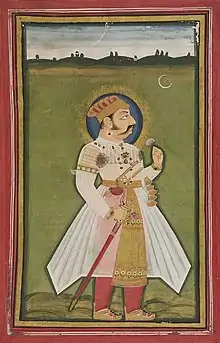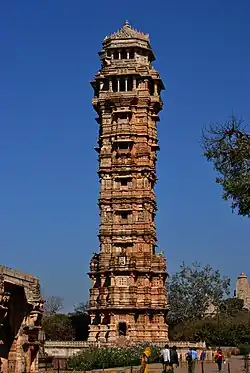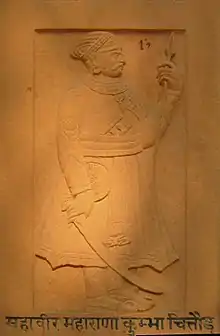Kumbha of Mewar
Kumbhakarna Singh (r. 1433–1468 CE), popularly known as Maharana Kumbha, was the Maharana of the Kingdom of Mewar in India.[4] He belonged to the Sisodia clan of Rajputs.[5] It was during his reign that Mewar became one of the most powerful powers in the northern India. He was the most powerful sovereign of his time.[6]
| Maharana Kumbha | |||||
|---|---|---|---|---|---|
| Maharana Abhinav Bharatacharya[1] Veenavadan Pravinen Paramguru Hindu Surtan[2] | |||||
 Portrait of Maharana Kumbha | |||||
| Rana of Mewar | |||||
| Reign | 1433–1468 | ||||
| Coronation | 1433 CE [3] | ||||
| Predecessor | Mokal Singh | ||||
| Successor | Udai Singh I | ||||
| Died | 1468 | ||||
| Issue | Udai Singh I Rana Raimal | ||||
| |||||
| Dynasty | Sisodias of Mewar | ||||
| Father | Mokal Singh | ||||
| Mother | Sobhagya Devi | ||||
| Religion | Hinduism | ||||
Early life
Rana Kumbha was born at Madariya,[7] in a Hindu Rajput family of Sisodia clan.[5] Kumbha was a son of Rana Mokal Singh of Mewar by his wife, Sobhagya Devi, a daughter of Jaitmal Sankhla, the Paramara fief-holder of Runkot in the state of Marwar. He was the 48th Rana of Mewar and succeeded Rana Mokal Singh in the year 1433 CE as the ruler of Mewar.[8]
Early period
Kumbha's father was assassinated of his own kins named Chacha and Maira. However with the help of King of Marwar Rao Ranmal Rathore whom Mokal had helped to become the king. He was able to defeat the murderers of his father and secure the throne of Mewar for himself, but due to the growing powers of Rathores in Mewari court and Ranmal's influence among Rajputs. Kumbha had Ranmal assassinated[9] and with the assassination of Ranmal, Kingdom of Marwar came into the hands of Kumbha.[10] It took Jodha son of Ranmal seven years too re conqueror Marwar from Kumbha. When he was engaged with the sultan of Malwa but at the same time seeing the stable postion of Mewar and his depleted Kingdom, who could no afford a war. He made a truce.[11]
Conquest of Malwa Sultanate
As one of the assassins of Mokal, Mahpa Panwar, was sheltered by the Sultan of Mandu, a demand for his person was made by the Maharana, but Mahmud Khilji refused to surrender the refugee. The Maharana prepared for hostilities and advanced to attack Mandu. The Sultan advanced with a powerful army to meet Kumbha. Both the armies met at the battle of Sarangpur[12] After a severe engagement the sultan's army was defeated and sultan was forced to fled to the fort of Mandu, following the victory Rana Kumbha laid siege to the fort of Mandu and captured the sultan. Who was later freed. Rana captured the areas of Gagron, Ranthambore Sarangpur, Durganpur, Banswara and Raisen from the Malwa Sultanate. He also annexed region of Hadoti. In coming years Sultan made several attempts to revenge his defeats in the battle of Mandalgarh and Banas but every time he was defeated.[13]
Conquest of Nagore Sultanate
Rana Kumbha started the conquest of Nagore due the harsh treatment of Hindus there. Shams Khan son of the sultan of Nagore fled to Maharana Kumbha for shelter and help. Rana Kumbha who had long designs on Nagaur, gladly embraced this opportunity of carrying them out, and agreed to place Shams Khan on the throne of Nagaur on the condition that he acknowledged Rana Kumbha's supremacy by demolishing a part of the battlements of the fort of that place.Shams Khan accepted the terms.Rana Kumbha marched with a large army to Nagaur, defeated Mujahid, who fled towards Gujarat,[14] and placed Shams Khan on the throne of Nagaur, and demanded of him the fulfillment of the condition. But Shams Khan humbly prayed to the Maharana to spare the fort, for otherwise his nobles would kill him after the Maharana was gone. He promised to demolish the battlements himself later on. The Maharana granted this prayer and returned to Mewar.
No sooner, however, had Rana Kumbha reached Kumbalgarh when he got the news that Shams Khan instead of demolishing, began to strengthen the fortification of Nagaur. This brought Kumbha on the scene again with a large army. Shams Khan was driven out of Nagaur, which passed into Kumbha's possession. The Maharana now demolished the fortification of Nagaur and thus carried out his long-cherished design. With the conquest of Nagore areas of Janglaudesha and Sapdalpaksha also came under him. Shams Khan fled to Ahmedabad,[15]
Conquest of the Gujarat Sultanate
Shams Khan sultan of Nagore fled to Ahmedabad, taking with him his daughter, whom he married to Sultan Qutb-ud-din Ahmad Shah II. The Sultan thereupon espoused his cause and sent a large army under Rai Ram Chandra and Malik Gadday to take back Nagaur. Rana Kumbha allowed the army to approach Nagaur, when he came out, and after a severe engagement, inflicted a crushing defeat on the Gujarat Sultanate army, annihilating it. Only remnants of it reached Ahmedabad, to carry the news of the disaster to the Sultan. The Sultan now took the field in person, determined to wrest Nagor back from the Maharana. The Maharana advanced to meet him and came to Mount Abu. In S. 1513 (A.D. 1456) the Sultan of Gujrat "despairing of reducing Chitor" arrived near Abu and sent his Commander-in-Chief, Malik Shaaban Imad-ul-Mulk, with a large army, to take the fort of Abu, and himself marched upon the fortress of Kumbhalgarh. Kumbha, aware of this plan, came out, attacked and "defeated Imad-ul-Mulk with great slaughter," and He by forced marched Kumbhalgarh before the Sultan arrived there. He also conquered regions of Abu and Sirohi.[16]
Fighting the combined attacks of the Sultanate of Malwa, Gujarat and Nagore
After getting repeatedly defeated by Kumbha Sultans of Gujrat, Malwa and Nagor prepared to take joint actions against Mewar and divide the spoils. Sultan of Gujrat move towards Kumbalgarh but was defeated there.[17] Nagor was also defeated. Sultan of Malwa took Mewar territories up to Ajmer but after seeing defeats of the sultans of Gujrat and Nagor allowed Rana Kumbha to recapture his lost territories.[18]
Construction of forts

Kumbha is credited with having worked assiduously to build up the state again. Of 84 fortresses that form the defense of Mewar, 32 were erected by Kumbha.[5] The chief citadel of Mewar, is the fort of Kumbhalgarh, built by Kumbha. It is the highest fort in Rajasthan (MRL 1075m).
Other architecture

Rana Kumbha commissioned the construction of a 37-metre (121 ft) high, nine-storey tower at Chittor. The tower, called Vijay Stambha (Tower of Victory), was completed probably between 1458 and 1468, although some sources date it to 1448.[19][20] The tower is covered with sculptures of Hindu gods and goddesses and depicts episodes from the Ramayana and the Mahabharata.
There are many inscriptions on the Stambha from the time of Kumbha.
- Verse 17: Kumbha is like the mountain Sumeru for the churning of the sea of Malwa.
- Verse 20: He also destroyed other lowly Mleccha rulers (of the neighborhood). He uprooted Nagaur.
- Verse 21: He rescued twelve lakh cows from the Muslim possession and converted Nagaur into a safe pasture for them. He brought Nagaur under the control of the Brahmanas and secured cows and Brahmanas in this land.
- Verse 22: Nagaur was centre of the Mleccha. Kumbha uprooted this tree of evil. Its branches and leaves were automatically destroyed.
The Ranakpur Trailokya-dipaka Jain temple with its adornments, the Kumbhashyam temple and Adivarsha temples of Chittor and the Shantinatha Jain temple are some of the many other structures built during Rana Kumbha's rule.
Contributions in arts and music
Kumbha was himself well versed in veena playing and patronised musicians as well as artists in his court. He himself wrote a commentary on Gita Govinda of Jaidev and an explanation on Chandisatkam. He also wrote treatises on music called "Sageet raj", "Sangeet mimansa"; "Sangeet ratnakar" and "Shudprabandha". He was the author of four dramas in which he used Sanskrit, Prakrit, and local Rajasthani dialects. In his reign, the scholars Atri and his son Mahesa wrote Prashashti on Kirti stambha. He was well versed in Vedas, Upanishad, and Vyakrana.[21]
Death and aftermath

Kumbha was killed by his son Udaysimha (Udai Singh I), who thereafter became known as Hatyara (Murderer). He was murdered at the time when he was sitting and praying at the edge of Mamadeva near the temple of Kumbhaswami at Kumbhalgarh.[22] Udai himself died in 1473, with the cause of death sometimes being stated as a result of being struck by lightning but more likely to have also been murder.[19]
See also
References
- Hooja, Rima (2006). A History of Rajasthan. New Delhi: Rupa Publication. p. 476. ISBN 81-291-0890-9.
- Hooja, Rima (2006). A History of Rajasthan. New Delhi: Rupa Publication. p. 476. ISBN 81-291-0890-9.
- Sarda, Har Bilas (1917). Maharana Kumbha. Ajmer, Rajputana Agency, British India: Ajmer; 1917. pp. 14–18. ISBN 978-9-38060-734-4.
- Sharma 1970, p. 5.
- Sen, Sailendra (2013). A Textbook of Medieval Indian History. Primus Books. pp. 116–117. ISBN 978-9-38060-734-4.
- Sarda, Har Bilas (1917). Maharana Kumbha: sovereign, soldier, scholar. University of California Libraries. Ajmer, Scottish Mission Industries co.
- "Maharana Kumbha Memorial". dnaindia.com.
- Sarda, Har Bilas (1917). Maharana Kumbha. Ajmer, Rajputana Agency, British India: Ajmer; 1917. pp. 14–18. ISBN 978-9-38060-734-4.
- Sarda, Har Bilas (1917). Maharana Kumbha: sovereign, soldier, scholar. University of California Libraries. Ajmer, Scottish Mission Industries co.
- Sarda, Har Bilas (1917). Maharana Kumbha: sovereign, soldier, scholar. University of California Libraries. Ajmer, Scottish Mission Industries co.
- Sarda, Har Bilas (1917). Maharana Kumbha: sovereign, soldier, scholar. University of California Libraries. Ajmer, Scottish Mission Industries co.
- Sarda, Har Bilas (1917). Maharana Kumbha: sovereign, soldier, scholar. University of California Libraries. Ajmer, Scottish Mission Industries co.
- Sarda, Har Bilas (1917). Maharana Kumbha: sovereign, soldier, scholar. University of California Libraries. Ajmer, Scottish Mission Industries co.
- Sarda, Har Bilas (1917). Maharana Kumbha: sovereign, soldier, scholar. University of California Libraries. Ajmer, Scottish Mission Industries co.
- Sarda, Har Bilas (1917). Maharana Kumbha: sovereign, soldier, scholar. University of California Libraries. Ajmer, Scottish Mission Industries co.
- Sarda, Har Bilas (1917). Maharana Kumbha: sovereign, soldier, scholar. University of California Libraries. Ajmer, Scottish Mission Industries co.
- Sarda, Har Bilas (1917). Maharana Kumbha: sovereign, soldier, scholar. University of California Libraries. Ajmer, Scottish Mission Industries co.
- Sarda, Har Bilas (1917). Maharana Kumbha: sovereign, soldier, scholar. University of California Libraries. Ajmer, Scottish Mission Industries co.
- Ring, Trudy; Watson, Noelle; Schellinger, Paul, eds. (2012). Asia and Oceania: International Dictionary of Historic Places. Routledge. p. 193. ISBN 978-1-13663-979-1.
- "Chittaurgarh Fort, Dist. Chittaurgarh". Archaeological Survey of India. Archived from the original on 21 October 2007.
- Saryu Doshi, Narayana Menon (1982). The Performing Arts. Marg Publications. ISBN 0391029177. Retrieved 17 August 2020.
- ambiladharma (7 July 2023). "Rare achievements of Maharana kumbha in military and architect". Retrieved 21 September 2023.
Bibliography
- Ram Vallabh Somani (1976). History of Mewar, from Earliest Times to 1751 A.D. Mateshwari. OCLC 2929852.
Further reading
Sharma, Dashrath (1970). Lectures on Rajput history and culture. Jawahar Nagar, Delhi: Motilal Banarsidass. ISBN 0-8426-0262-3.